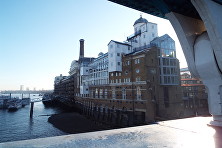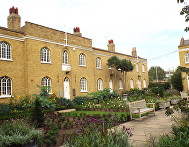





Exploring Southwark and discovering its history


Latest Pages:
Bermondsey Street
Bermondsey Street is one of the oldest streets in London with a history going back over 1,000 years. It runs diagonally south west from Tooley Street down to Tower Bridge Road and has had many lives, from a route of pilgrimage and an area of market gardens and fields, then an urban industrial area through to the gentrified street of today with its restaurants, coffee houses, artisan food producers, and design and tech studios working from converted warehouses, factories and Victorian terraced houses.
Once called Barnabye Street or Barmsie Street, the route of Bermondsey Street reflects the footpath taken by pilgrims from the City of London to Bermondsey Abbey to see the Rood of Grace, said to have miraculous powers. After crossing the River Thames via old London Bridge, the pilgrims would have walked along Tooley Street passing the palace and gardens belonging to the Abbots of Battle and then turning right at the edge of the Abbots’ land. It’s thought that the route follows the line of an ancient causeway through the swamps of Bermondsey that had been drained in Saxon times with farms created on the reclaimed land.
Bermondsey Abbey was situated in the area between present day Bermondsey Street, Abbey Street and Grange Walk. The Abbey court yard was located in Bermondsey Square at the centre of this area and it’s possible to see a part of the Abbey’s stonework beneath glass in the floor of Lokma Turkish Bar and Grill. The Rood of Grace was a crucifix, found in 1117, besides the River Thames or some say dredged out from the River Thames. A servant of the Abbey passing along the river’s bank one day happened upon it and Edward T Clarke, in his local history Bermondsey: Its Historic Memories and Associations (1902), continues the tale: “”Filled with terror and amazement, not daring to touch the sacred emblem, which to his untutored mind would seem to have dropped from the clouds, he flew to the monastery to relate his marvellous discovery. The monks would have gone in procession to the spot caused the previous relic to be reverently raised, and borne with all solemnity to the priory church, there to be enshrined. The church was dedicated to the Saviour: this miraculous discovery of His image may have seemed a pledge of Divine favour, a visible token of the Lord’s grace, a sign that the soil on which the effigy of the Redeemer had been deposited was thereby hallowed, that the monastery [the Abbey] and its possessions were taken under His special protection.”
Word spread that miraculous recoveries and marvellous escapes had been brought about as the result of petitions offered to the Rood of Grace. It attracted increasing numbers of pilgrims and Bermondsey Street became a busy thoroughfare lined with inns and other businesses with fairs and markets to cater for the pilgrims. Some sources say that the Holy Cross of Bermondsey was an alternative name for the Rood of Grace, while others say the Holy Cross of Bermondsey was the name of a cross erected at the junction of Tooley Street and the footpath that became Bermondsey Street and shown on a map of 1542. Either way, it gave its name to Crucifix Lane leading off Bermondsey Street at the northern end. Although the inns have disappeared, they gave their name to some of the yards still surviving that lead off Bermondsey Street for example Black Swan Yard, Bell Yard Mews and Royal Oak Yard.
So Bermondsey Street in medieval times was “neither dull nor unfrequented.” In addition to the steady stream of pilgrims, there were royal processions and the progress of knights and barons to Parliaments held at the Abbey. Crusaders travelled along Bermondsey Street on their way to the Abbey where they held council in preparation for their journey to the Holy Land.



Bermondsey Street 1755, long before the building of the railway and Tower Bridge Road. Section from a Map of the Parish of St Mary Magdalen, Bermondsey


Bermondsey Abbey surrendered to Henry VIII when the monasteries were dissolved in 1536. The Rood of Grace was taken down in 1558. A large part of Bermondsey Abbey was demolished soon after and the materials used to build a grand house for Sir Thomas Pope. The church of St Mary Magdalen attached to the Abbey as a place of worship for servants of the Abbey and the lay population survived the reformation when it became the Protestant parish church.
While retaining the medieval tower, it was demolished and rebuilt at the end of the 17th century with further additions in the 18th century and alterations in the early 19th century. The attached graveyard on the corner of Bermondsey Street and Abbey Street was closed for burials in 1854 and donated to Bermondsey Vestry in 1883 when it was laid out as a public recreation ground. The watch-house on the corner of Bermondsey Street and Abbey Street also still survives and is now a café.
By the end of the 16th century, there were buildings backing on to open fields lining the full length of both sides of Bermondsey Street. Gradually the open fields were built over, at the northern end at first, and by the middle of the 19th century, no open fields remained. The area had become highly industrial and tanning and its associated processes dominated the area as the City of London had long banned the tanning industry for its foul and noxious smells and processes. Bermondsey had become home to the industry at an early stage, even Chaucer had described “the tan yeardes of Bermondsie” in The Pilgrims Progress. The Leather and Skin Market had opened in Weston Street off Bermondsey Street in 1833 and in 1878, a commentator wrote “from the following enumeration of some of the manufacturers in Bermondsey Street alone, it will be seen how many branches of industry are carried on here in connection with the leather trade: hidesellers, tanners, leather-dressers, morocco leather dressers, leather sellers and cutters, curriers, parchment-makers, wool-staplers, horsehair manufacturers, hair and flock manufacturers, patent hairfelt manufacturers. There are besides these skin and hide salesmen, fellmongers, leather-dyers, and glue-makers, in other parts of the vicinity.”
But while a look at a trade directory for Bermondsey Street in 1841 reveals an emphasis on the tanning trade and related industries, there were also many entries for businesses that show the street to have been a healthy high street with such shops as butchers, bakers, grocers, cheese mongers, fruiterers, chemists, tobacconists, hairdressers and pawnbrokers to serve those who lived and worked locally. The trade directory in 1910 shows there were fewer of these smaller shops and instead, in addition to the tanning and leather industry whose numbers have also declined, other types of larger businesses have moved in including printers, a wholesale stationer, a bedstead manufacturer, a boiler maker, an electrical company, tin plate workers and manufacturing chemists. There was also the factory and offices of Christy and Co, said to be the largest hat factory in the world.
A photograph of old houses in Bermondsey Street estimated to have been taken between 1876 and 1886. The premises shown on the left are those of William Pettit, rug makers at 89 and 94 Bermondsey Street (street numbering has changed). They also had premises in Blue Anchor Lane (now Southwark Park Street). From The British Library
The number of pubs listed in the 1841 directory had also declined by 1910 but the Woolpack is listed in both directories and survives today. This commemorates the woolstapling trade that took place in and just off Bermondsey Street and is described by Charles Knight as “wooldealers who purchase the commodity as taken from the skins, and sell it to the hatters, the woollen and worsted manufacturers, and others. They are scarcely to be denominated manufacturers, since the wool passes through their hands without undergoing any particular change or preparation; it is sorted into various qualities" There were a number of large warehouses belonging to the wool-staplers in Russell Street (now Tanner Street) “with cranes over them; wagons in the yard beneath; huge bags filled with wool.”
The parish of St Mary Magdalen workhouse was built in Russell Street in 1791 and later became a part of the enlarged St Olave Poor Law Union. The workhouse was said to consist of an extensive range of buildings that formed a large square court and covered a large area. When the workhouse was demolished some time after World War I, it was laid out to form Tanner Street Park as the result of extensive campaigning by Dr Alfred Salter. Later, the houses between the park and Bermondsey Street were demolished and the park extended.
The tanning and leather trade suffered a decline from the end of the 19th century for many reasons. Other towns developed as tanning centres both in the UK and overseas, and Bermondsey became a centre for the sale of processed leather and leather goods manufactured elsewhere. The replacement of horses by motorised transport drastically reduced the demand for saddlery and by the 1960s, many goods once made from leather were now made from man-made synthetics. At this time, the nearby Port of London closed as shipping became containerised requiring deep docks such as Tilbury and and Felixstowe and from the 1960s / 1970s a hush fell over Bermondsey Street, no longer the bustling place it had once been. Some buildings became derelict and many shopfronts were boarded up.
Since then the street has risen again to reflect the industries and interests of the late 20th and early 21st centuries. Regeneration brought The White Cube Gallery and the Fashion and Textile Museum to Bermondsey Street. Many of the Victorian houses and industrial buildings remain, looking cleaner and often with contemporary embellishments, that stand alongside newer buildings. The street has character and visitors who wouldn’t have dared visit 30 years ago are now attracted to the bars and restaurants to make it a thriving street once more.
Web discoveries
- UK Casino Not On Gamstop
- UK Casino Not On Gamstop
- Non Gamstop Casino
- Casinos Not On Gamstop
- Non Gamstop Casinos
- Non Gamstop Casinos
- Non Gamstop Casino
- Casinos Not On Gamstop
- Casino Sites Not On Gamstop
- Slots Not On Gamstop
- Casinos Not On Gamstop
- UK Betting Sites Not On Gamstop
- UK Casino Not On Gamstop
- Best Non Gamstop Casinos
- Betting Sites
- Non Gamstop Casino Sites UK
- Best Non Gamstop Casinos
- Non Gamstop Casino
- Casinos Not On Gamstop
- Non Gamstop Casino Sites UK
- Horse Racing Betting